
Pop Art - I
POP ART
Pop art is an art movement that emerged in the United Kingdom and the United States during the mid- to late-1950s. The movement presented a challenge to traditions of fine art by including imagery from popular and mass culture, such as advertising, comic books and mundane mass-produced objects. One of its aims is to use images of popular culture in art, emphasizing the banal or kitschy elements of any culture, most often through the use of irony. It is also associated with the artists' use of mechanical means of reproduction or rendering techniques. In pop art, material is sometimes visually removed from its known context, isolated, or combined with unrelated material.
Amongst the early artists that shaped the pop art movement were Eduardo Paolozzi and Richard Hamilton in Britain, and Larry Rivers, Ray Johnson, Robert Rauschenberg and Jasper Johns among others in the United States. Pop art is widely interpreted as a reaction to the then-dominant ideas of abstract expressionism, as well as an expansion of those ideas. Due to its utilization of found objects and images, it is similar to Dada. Pop art and minimalism are considered to be art movements that precede postmodern art, or are some of the earliest examples of postmodern art themselves.
Pop art often takes imagery that is currently in use in advertising. Product labeling and logos figure prominently in the imagery chosen by pop artists, seen in the labels of Campbell's Soup Cans, by Andy Warhol. Even the labeling on the outside of a shipping box containing food items for retail has been used as subject matter in pop art, as demonstrated by Warhol's Campbell's Tomato Juice Box, 1964 (pictured).
Mimmo Rotella
1918 – 2006
Mimmo Rotella
Domenico "Mimmo" Rotella (Catanzaro, 7 October 1918 – Milan, 8 January 2006) was an Italian artist considered an important figure in post-war European art. Best known for his works of décollage and psychogeographics, made from torn advertising posters. He was associated to the Ultra-Lettrists an offshoot of Lettrism and later was a member of the Nouveau Réalisme, founded in 1960 by the art critic Pierre Restany.
Décollages
Décollage is an artistic technique of collage to the opposite procedure. Instead of adding elements of the work, it starts from an artistic object from which the parts are detached. The idea of decollage was born during a period of "artistic crisis" and took place following the trip to the US, during which he was in contact with members of the New Dada. Back in Rome he became inspired by torn posters around the town and began to carry them in his studio and to work on them. The result was the creation of canvases on which Rotella pasted one or more pieces of torn posters, often superimposed. Rotella wanted to somehow find some form of artistic innovation and at the same time give artistic dignity to a common object, and of little value removed from its natural environment. The first trials of Rotella with decollage date back to 1953. The first decollage, in most small cases, were exhibited for the first time in the spring of 1955.
Retro d'affiches
The two roads that Rotella takes on simultaneously, starting in 1953-1954 are those of decollage and retro posters. The first retro d'affiche documented back to 1954. The retro d'affiche are displayed for the first time to the public in December 1955 at the personal exhibition the artist held at the Galleria del Naviglio in Milan. Unlike decollage where often textural layers are wrapped together and manipulated, in the back of posters the artist retains the "urban relic". In these works his speech tends to be subtle, the colors are often absent, the surface is gritty and raw, it has compared to decollage a more targeted research to informal language, except that it will become evident starting especially from the sixties when decollages in expected to bet influenced by the rising pop language.

Mimmo Rotella

Tracce
Mimmo Rotella
1955

Untitled
Mimmo Rotella
1957

Untitled
Mimmo Rotella
1959

Caffè
Mimmo Rotella
1960

Untitled
Mimmo Rotella
1961

Cinemascope
Mimmo Rotella
1962

Mimmo Rotella

Mimmo Rotella

Marilyn
Mimmo Rotella
1963

Marlene
Mimmo Rotella
1964

Sotto le stelle 1
Mimmo Rotella
1967

Kriminal
Mimmo Rotella
1968

Pepsi
Mimmo Rotella
1979

The Look
Mimmo Rotella
1979

Universal
Mimmo Rotella

Fetish
Mimmo Rotella

Speak Up
Mimmo Rotella

A Love in Casablanca
Mimmo Rotella

Modi
Mimmo Rotella

Cinema
Mimmo Rotella

Mimmo Rotella,
Viva America,
1963.

Marilyn
Mimmo Rotella

Mimmo Rotella
“Ombre Rosse”

Mimmo Rotella
“The Asphalt Jungle”

Marilyn
Mimmo Rotella

The fifty faces of Marylin
Mimmo Rotella
William N. Copley
1919 – 1996
William N. Copley
(January 24, 1919 – May 7, 1996) also known as CPLY, was an American painter, writer, gallerist, collector, patron, publisher and art entrepreneur. His works as an artist have been classified as late Surrealist and precursory to Pop Art.
Copley was born in New York City in 1919 to parents John and Flora Lodwell; they died shortly after in the 1919 Spanish Flu epidemic. Copley was adopted in 1921 by Ira C. Copley, the owner of sixteen newspaper companies in Chicago and San Diego. Ira C. Copley remarried after the death of his wife, Edith, several years after the adoption took place. The three lived in Aurora, Illinois, until Copley was ten years old whereby the family moved to Coronado Island, California.
Copley was sent to Phillips Andover and then Yale University by his adopted parents. He was drafted in the Second World War in the middle of his education at Yale, a decision negotiated by the school and the army. Copley experimented with politics upon returning home from the war, working as a reporter for his father's newspaper.
By 1946, Copley met and married Marjorie Doris Wead, the daughter of a test pilot for the Navy. Doris's sister was married to John Ployardt, a Canadian-born animator and narrator at Walt Disney Studios. Copley and Ployardt soon became friends and Ployardt began introducing Copley to painting and Surrealism. The two traveled to Mexico and New York, discovering art, meeting the artists behind the works, and grasping Surrealist ideas. It was during this time that Copley and Ployardt decided to open a gallery in Los Angeles to exhibit Surrealist works.

William N. Copley

William N. Copley

William N. Copley

William N. Copley
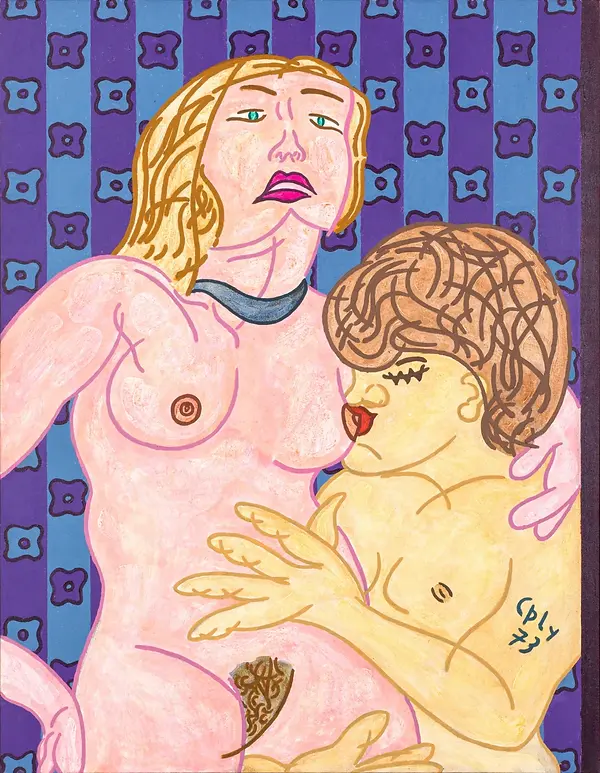
William N. Copley

William N. Copley

William N. Copley

William N. Copley

William N. Copley

William N. Copley

William N. Copley
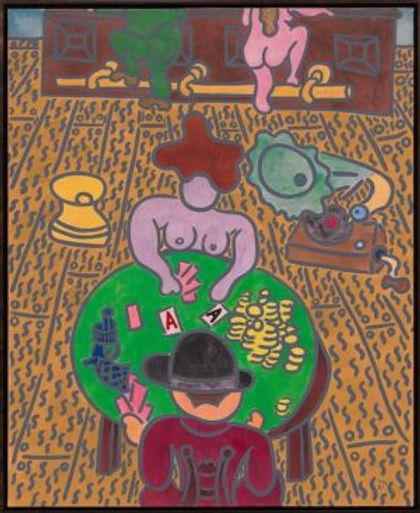
William N. Copley
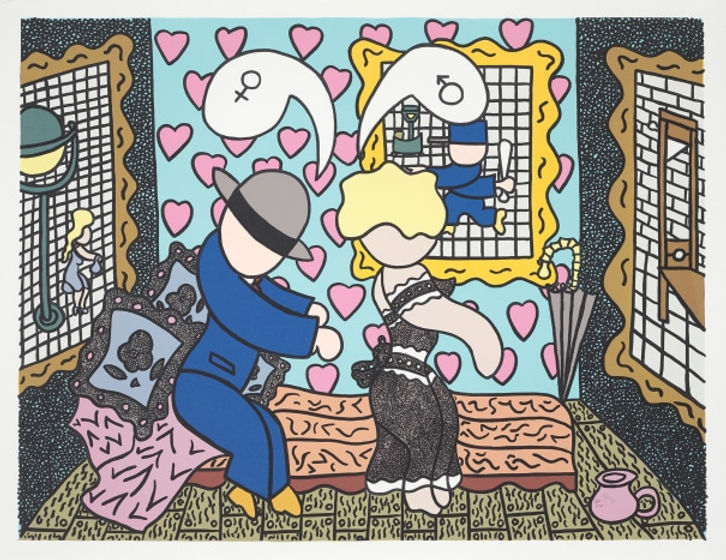
William N. Copley

William N. Copley

William N. Copley

William N. Copley

William N. Copley

William N. Copley
LeRoy Neiman
1921 – 2012

LeRoy Neiman
LeRoy Neiman
(born LeRoy Leslie Runquist, June 8, 1921 – June 20, 2012) was an American artist known for his brilliantly colored, expressionist paintings and screenprints of athletes, musicians, and sporting events.
Neiman was born in 1921 in Saint Paul, Minnesota, the son of Lydia Sophia (née Serline), of Braham, Minnesota, and Charles Julius Runquist, who were married in 1918 and lived in Grasston, Minnesota (Kanabec County). He was of Turkish and Swedish descent ("as near as I can figure out", as he has said). His father deserted his family, and when his mother married his stepfather, John L. Niman (Neiman) in 1926, LeRoy changed to the new surname as well. His mother divorced Neiman about 1935, and married for the third time in about 1940, to Ernst G. Hoelscher, of St. Paul. She died in St. Paul on November 14, 1985, aged 87. LeRoy was raised in the Macalester-Groveland and Frogtown neighborhoods of St. Paul. The home he lived in the longest, from about 1940 to about 1955, still stands at 569 Van Buren Avenue.

Vegas
LeRoy Neiman
1961
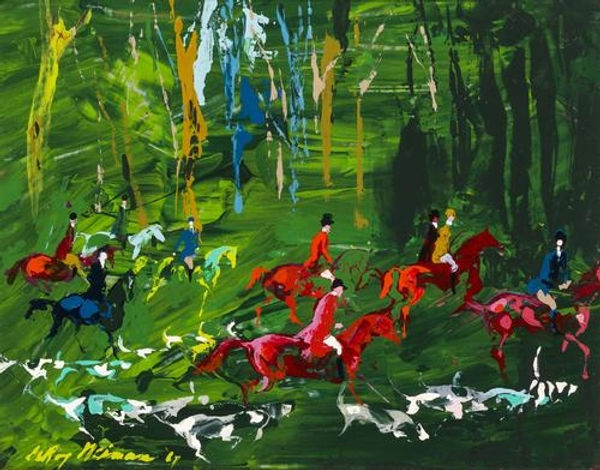
Hunt Field
LeRoy Neiman
1967

Abraham Lincoln
LeRoy Neiman
1968

Olympic Track
LeRoy Neiman
1970

Fencing at Munich Olympics
LeRoy Neiman
1972

Red Sky
LeRoy Neiman
1977
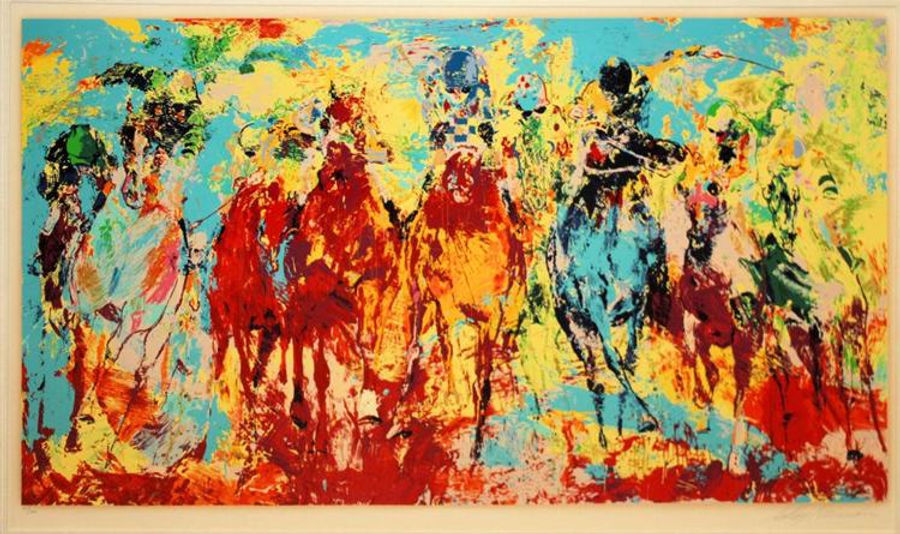
Stretch Stampede
LeRoy Neiman
1979

In the Pocket
LeRoy Neiman
1988

The Gaming Table
LeRoy Neiman
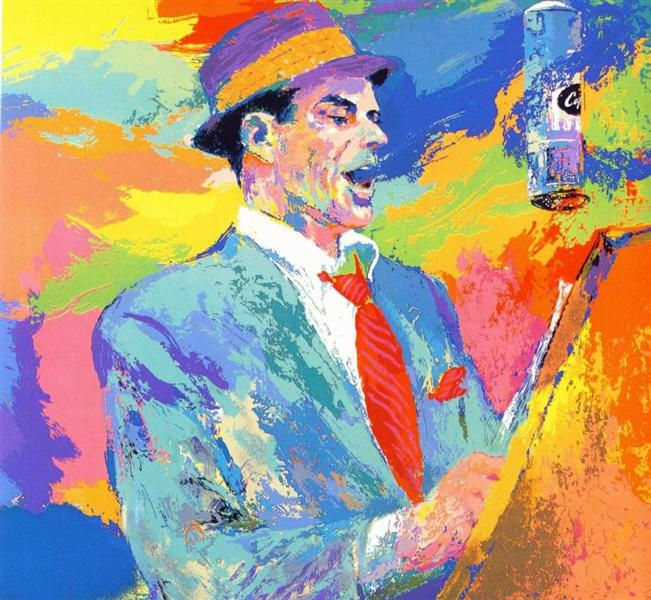
LeRoy Neiman

Bistro Garden
LeRoy Neiman

John Elway
LeRoy Neiman
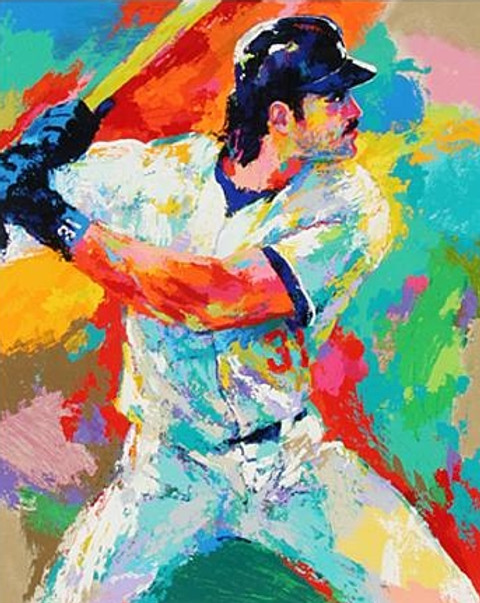
Mike Piazza
LeRoy Neiman

Muhammad Ali: The Athlete of the Century
LeRoy Neiman

Elephant Family
LeRoy Neiman

Portrait of the Elephant
LeRoy Neiman

Resting Lion
LeRoy Neiman

Resting Tiger
LeRoy Neiman

Rocky Balboa
LeRoy Neiman

Shaq
LeRoy Neiman

Stan Smith
LeRoy Neiman

LeRoy Neiman
Richard Hamilton
1922 – 2011
Richard William Hamilton (24 February 1922 – 13 September 2011) was an English painter and collage artist. His 1955 exhibition Man, Machine and Motion (Hatton Gallery, Newcastle upon Tyne) and his 1956 collage Just what is it that makes today's homes so different, so appealing?, produced for the This Is Tomorrow exhibition of the Independent Group in London, are considered by critics and historians to be among the earliest works of pop art. A major retrospective of his work was at Tate Modern until May 2014.

Richard Hamilton
Four Self-Portraits

Richard Hamilton
Just what was it that made yesterday’s homes so different, so appealing?

Just What Is It That Makes Today’s Homes So Different? by Richard Hamilton

Richard Hamilton
The Citizen

Richard Hamilton
1952, Refraction

Richard Hamilton
1958-61, $he
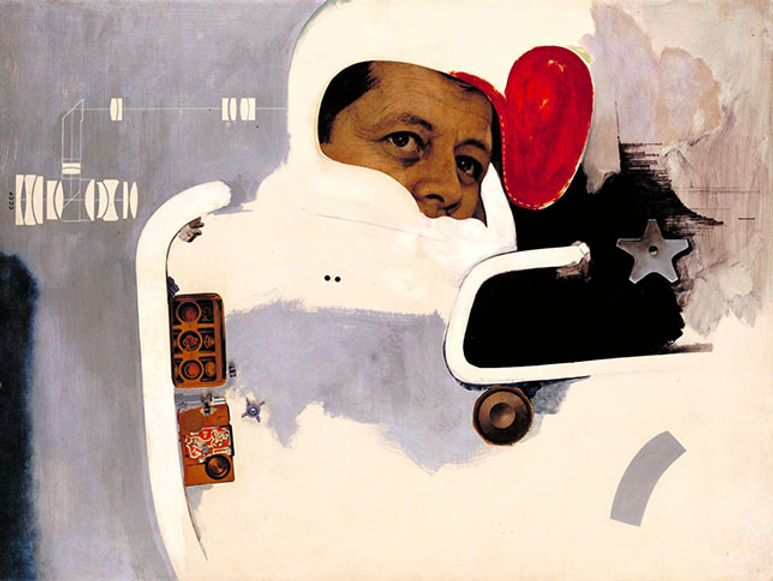
Richard Hamilton
1962, Towards a definitive statement on the coming trends in menswear and accessories (a) Together let us explore the stars

Richard Hamilton
1964-65, Interior

My Marilyn
Richard Hamilton
1965

Marcel Duchamp
Richard Hamilton
1968

Swingeing London 67
Richard Hamilton
1968 - 1969
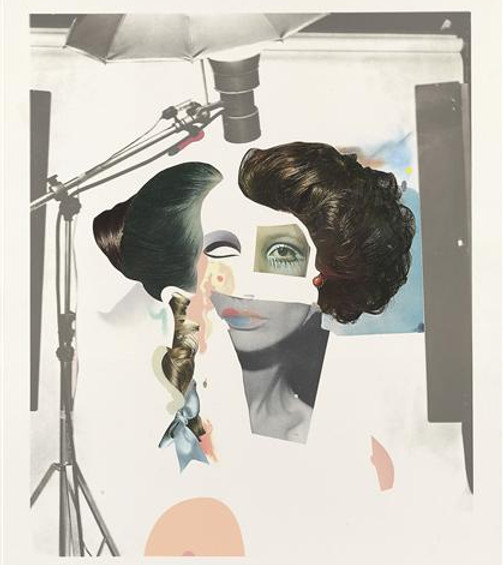
Fashion plate
Richard Hamilton
1970

Bronze by Gold
Richard Hamilton

Ireland a Nation
Richard Hamilton

A mirrorical return
Richard Hamilton

Chiara & chair
Richard Hamilton

The Beatles
Richard Hamilton
Roy Lichtenstein
1923 – 1997
.png)
ROY LICHTENSTEIN

Roy Fox Lichtenstein
(October 27, 1923 – September 29, 1997) was an American pop artist. During the 1960s, along with Andy Warhol, Jasper Johns, and James Rosenquist, he became a leading figure in the new art movement. His work defined the premise of pop art through parody. Inspired by the comic strip, Lichtenstein produced precise compositions that documented while they parodied, often in a tongue-in-cheek manner. His work was influenced by popular advertising and the comic book style. His artwork was considered to be "disruptive". He described pop art as "not 'American' painting but actually industrial painting". His paintings were exhibited at the Leo Castelli Gallery in New York City.

ROY LICHTENSTEIN

ROY LICHTENSTEIN
.png)
ROY LICHTENSTEIN

ROY LICHTENSTEIN
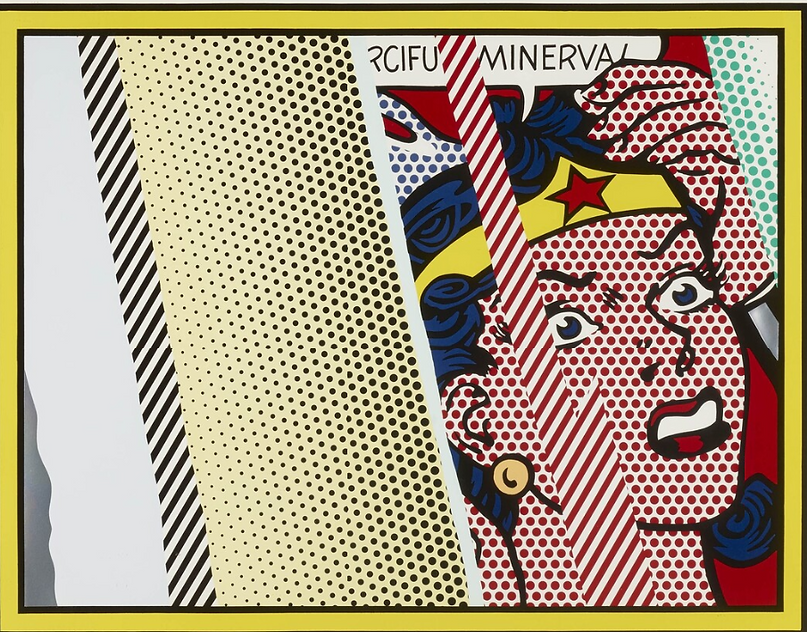
ROY LICHTENSTEIN

ROY LICHTENSTEIN

ROY LICHTENSTEIN

ROY LICHTENSTEIN
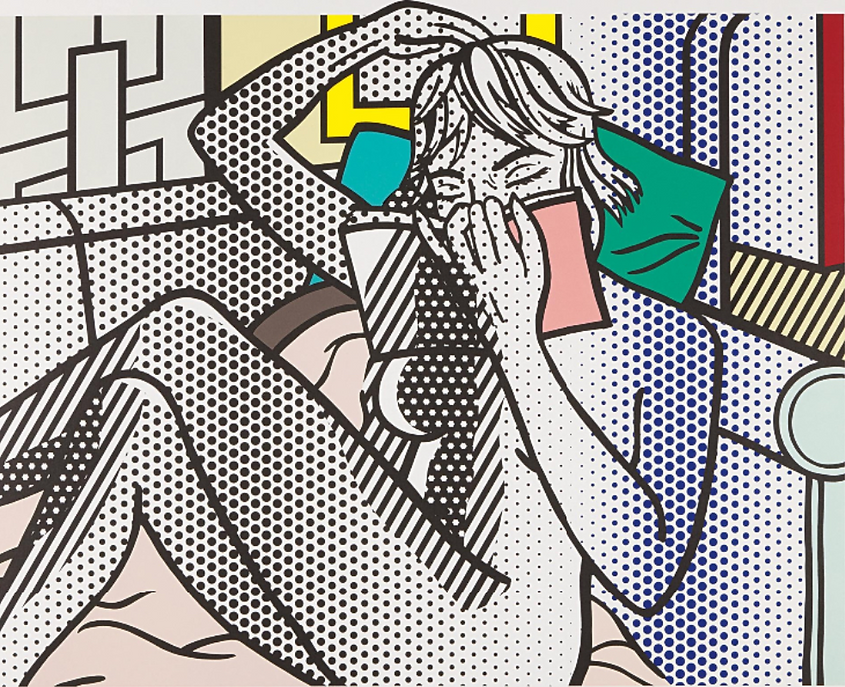
ROY LICHTENSTEIN

ROY LICHTENSTEIN

ROY LICHTENSTEIN

ROY LICHTENSTEIN

ROY LICHTENSTEIN

ROY LICHTENSTEIN

ROY LICHTENSTEIN
.png)
ROY LICHTENSTEIN
.png)
ROY LICHTENSTEIN
.png)
ROY LICHTENSTEIN

ROY LICHTENSTEIN

ROY LICHTENSTEIN
.png)
ROY LICHTENSTEIN
.png)
ROY LICHTENSTEIN
.png)
ROY LICHTENSTEIN
Larry Rivers
1923 – 2002
Larry Rivers
(born Yitzroch Loiza Grossberg; August 17, 1923 – August 14, 2002) was an American artist, musician, filmmaker, and occasional actor. Considered by many scholars to be the "Godfather" and "Grandfather" of Pop art, he was one of the first artists to merge non-objective, non-narrative art with narrative and objective abstraction.
Larry Rivers was born as Yitzroch Loiza Grossberg in the Bronx, New York, in the family of Jewish immigrants from Ukraine. Rivers took up painting in 1945 and studied at the Hans Hofmann School from 1947–48. He earned a BA in art education from New York University in 1951.
His work was quickly acquired by the Museum of Modern Art. A 1953 painting Washington Crossing the Delaware was damaged in fire at the museum five years later.
He was a pop artist of the New York School, reproducing everyday objects of American popular culture as art. He was one of eleven New York artists featured in the opening exhibition at the Terrain Gallery in 1955.
He has been contextualised as working out of the Abstract expressionist legacy of Willem de Kooning, "adapting the freedom of the Abstract Expressionist technique towards figurative ends."
During the early 1960s Rivers lived in Manhattan's Hotel Chelsea, notable for its artistic residents such as Bob Dylan, Janis Joplin, Leonard Cohen, Arthur C. Clarke, Dylan Thomas, Sid Vicious and multiple people associated with Andy Warhol's Factory and where he brought several of his French nouveau réalistes friends like Yves Klein who wrote there in April 1961 his Manifeste de l'hôtel Chelsea, Arman, Martial Raysse, Jean Tinguely, Niki de Saint-Phalle, Christo, Daniel Spoerri or Alain Jacquet, several of whom, like Rivers, left some pieces of art in the lobby of the hotel for payment of their rooms. In 1965, Rivers had his first comprehensive retrospective in five important American museums.
His final work for the exhibition was The History of the Russian Revolution, which was later on extended permanent display at the Hirshhorn Museum and Sculpture Garden in Washington, DC. He spent 1967 in London collaborating with the American painter Howard Kanovitz.
In 1967, Rivers traveled to Africa for a second time with Pierre Dominique Gaisseau to finish their documentary Africa and I, which was a part of the groundbreaking NBC series Experiments in Television. During this trip they narrowly escaped execution as suspected mercenaries.
During the 1970s, Rivers worked closely with Diana Molinari and Michel Auder on many video tape projects, including the infamous Tits, and also worked in neon.
Rivers's legs appeared in John Lennon and Yoko Ono's 1971 film Up Your Legs Forever.
In 1971, he curated Some American History at the Institute for the Arts at Rice University in Houston, where his own work was exhibited alongside that of Ellsworth Ausby, Peter Bradley, Frank Bowling, Daniel LaRue Johnson, Joe Overstreet, and William T. Williams.
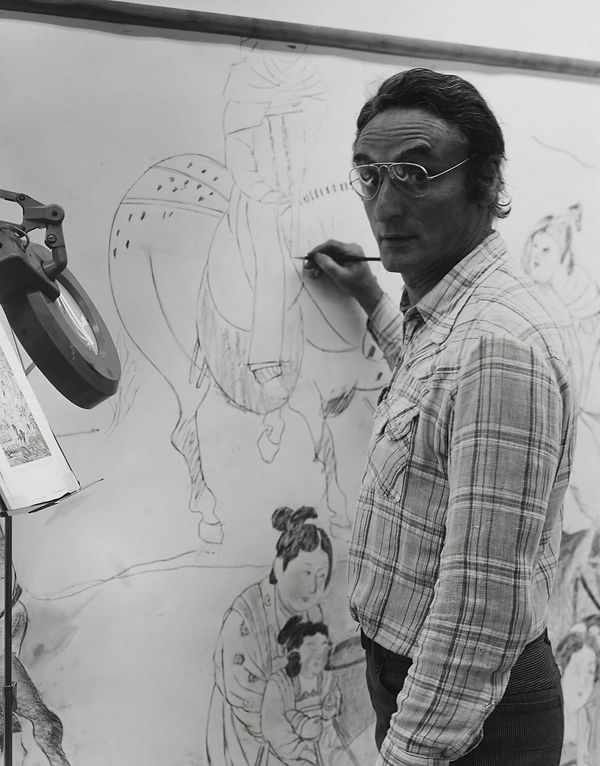
Larry Rivers

Larry Rivers
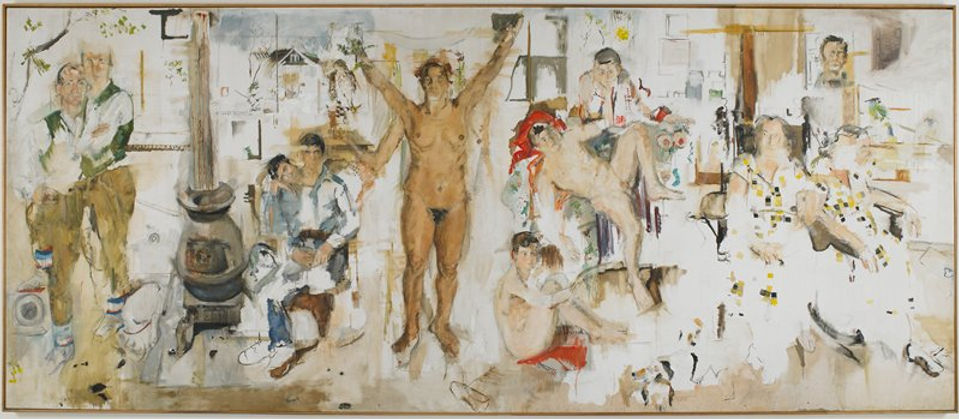
Larry Rivers

Larry Rivers (detail)

Larry Rivers (detail)

Larry Rivers

Larry Rivers

Larry Rivers

Larry Rivers

Larry Rivers

Larry Rivers

Larry Rivers

Larry Rivers

Larry Rivers

Larry Rivers

Larry Rivers

Larry Rivers

Larry Rivers

Larry Rivers

Larry Rivers

Larry Rivers

Larry Rivers

Larry Rivers

Larry Rivers
Eduardo Paolozzi
1924 – 2005
Eduardo Paolozzi
Sir Eduardo Luigi Paolozzi (7 March 1924 – 22 April 2005) was a Scottish artist, known for his sculpture and graphic works. He is widely considered to be one of the pioneers of pop art.
Eduardo Paolozzi was a Scottish artist and prominent influence on what became the Pop Art movement. He produced large-scale figurative sculptures, prints, and collages made from magazines and other found objects. “I like to make use of everything. I can't bear to throw things away—a nice wine bottle, a nice box,” he once said. “Sometimes I feel like a wizard in Toytown, transforming a bunch of carrots into pomegranates.” Born on March 7, 1924 in Leith, United Kingdom to Italian immigrants, he was sent to Fascist summer camps in Mussolini-era Italy as a boy. He was interned by the British government when Italy became involved in World War II, an experience which had a lasting impact on Paolozzi. He went on to study at University College's Slade School of Fine Art in London from 1944 to 1947. Moving to Paris that same year, he came into contact with many prominent Surrealists and Cubists, including Georges Braque, Fernand Léger, and Jean Arp. Returning to London in 1949, he became friends with Lucian Freud and Francis Bacon while teaching at the Central School of Art and Design. Over the following decades, Paolozzi enjoyed widespread success, including being knighted by Queen Elizabeth II in 1989, and numerous public art commissions. He died on April 22, 2005 in London, United Kingdom. Today, the artist’s works are held in the collections of the National Galleries of Scotland in Edinburgh, The Museum of Modern Art in New York, and the Tate Gallery in London, among others.

Eduardo Paolozzi

Eduardo Paolozzi
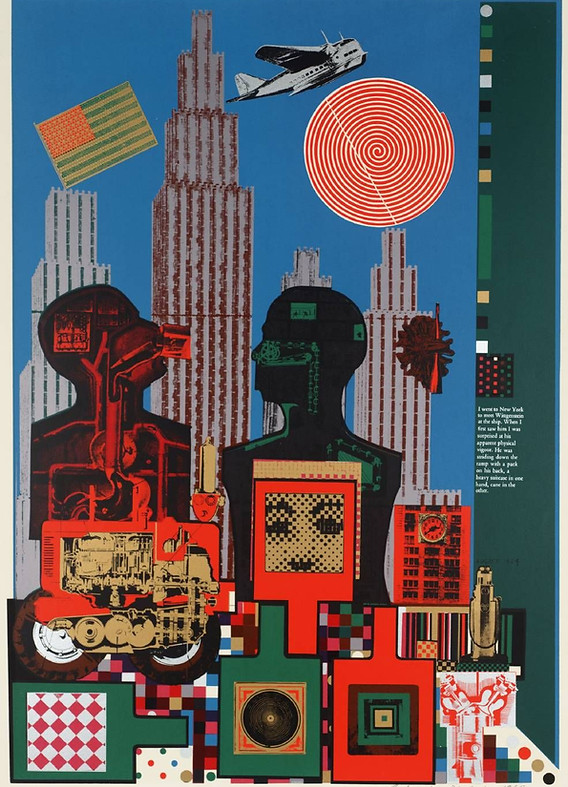
Eduardo Paolozzi
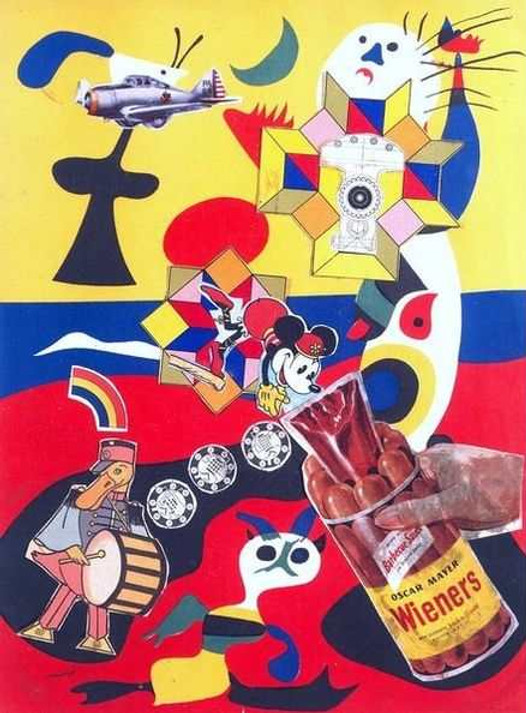
Eduardo Paolozzi

Eduardo Paolozzi

Eduardo Paolozzi

Eduardo Paolozzi

Eduardo Paolozzi

Eduardo Paolozzi

Eduardo Paolozzi

Eduardo Paolozzi

Eduardo Paolozzi

Eduardo Paolozzi

Eduardo Paolozzi

Eduardo Paolozzi

Eduardo Paolozzi

Eduardo Paolozzi

Eduardo Paolozzi
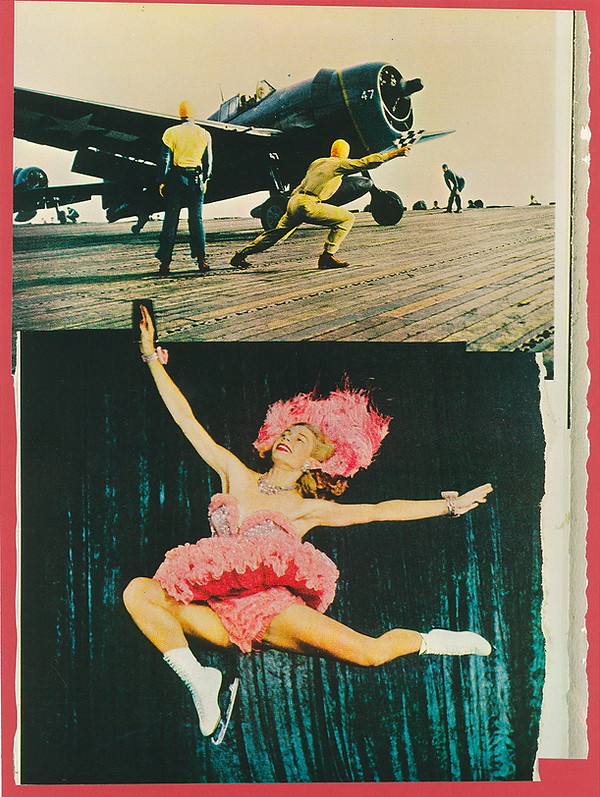
Eduardo Paolozzi

Eduardo Paolozzi

Eduardo Paolozzi

Eduardo Paolozzi

Eduardo Paolozzi

Eduardo Paolozzi
Jacques Monory
1924 – 2018

Jacques Monory
(25 June 1924 – 17 October 2018) was a French painter and filmmaker whose work, highly influenced by photography and cinema, is an allegory of the contemporary world with a focus on the violence of everyday reality. His canvases evoke a heavy atmosphere, pulling subject matter from modern civilization through the lens of his signature monochrome color blue.
Monory's work was exhibited from 12 January to 23 February 2018 at the Richard Taittinger Gallery in New York City. The New York Times featured the show in an article titled "What to See in New York Art Galleries This Week". Martha Schwendener wrote, "Mr. Monory’s canvases can be easily compared to the work of ’80s American postmodern painters like David Salle, Jack Goldstein, Troy Brauntuch and Eric Fischl, but he has a soft spot for older figurative artists, too, like Edward Hopper. “Spéciale n°54 Hommage à Hopper” (2007) features a house with a nearby road sign for the Hopper Center — although no such institution exists, except in this painting, which functions, as does most of Mr. Monory’s work, like a movie screen where fantastical drama and action are routinely played out.".

JACQUES MONORY: MURDER II. 1968.

JACQUES MONORY: MURDER VII.

JACQUES MONORY

JACQUES MONORY

JACQUES MONORY

JACQUES MONORY

JACQUES MONORY
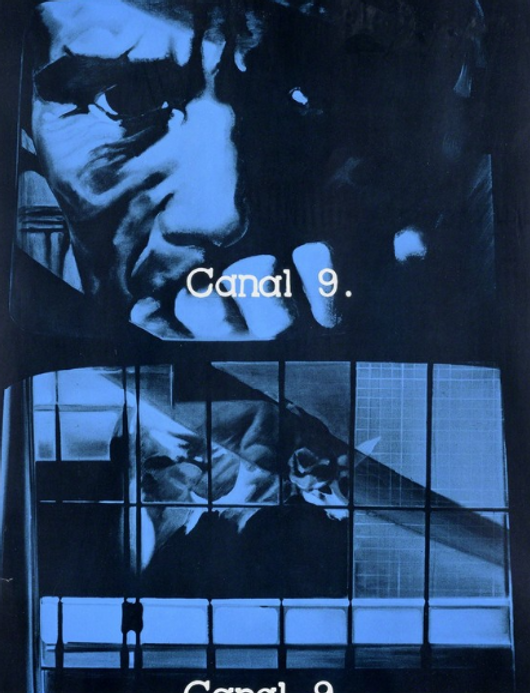
JACQUES MONORY

JACQUES MONORY
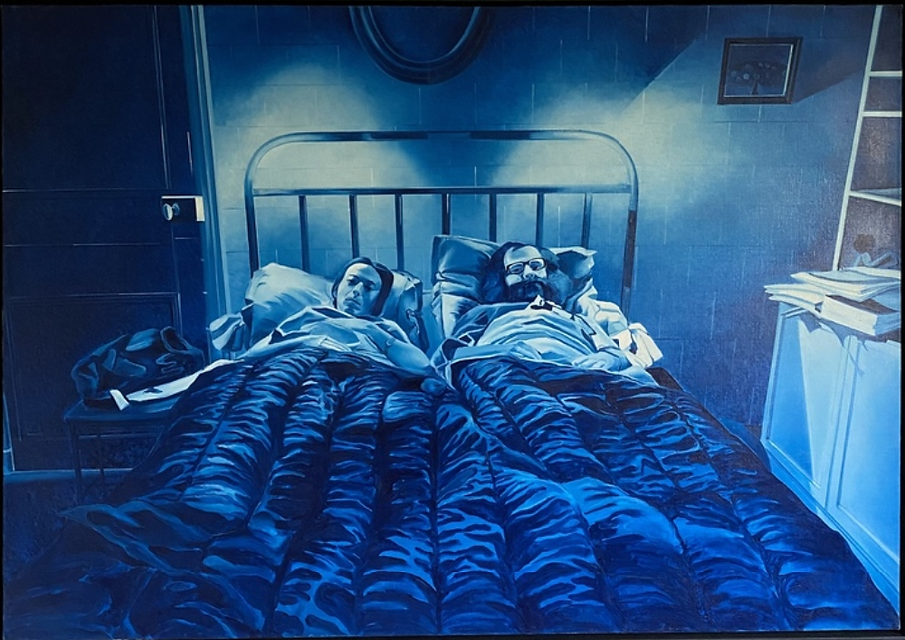
JACQUES MONORY

JACQUES MONORY

JACQUES MONORY

JACQUES MONORY

JACQUES MONORY

JACQUES MONORY

JACQUES MONORY
Robert Rauschenberg
1925 – 2008

ROBERT RAUSCHENBERG: CANYON. 1959. Pasadena. Art Museum
Milton Ernest "Robert" Rauschenberg
(October 22, 1925 – May 12, 2008) was an American painter and graphic artist whose early works anticipated the Pop art movement. Rauschenberg is well known for his Combines (1954–1964), a group of artworks which incorporated everyday objects as art materials and which blurred the distinctions between painting and sculpture. Rauschenberg was both a painter and a sculptor, but he also worked with photography, printmaking, papermaking and performance.
Rauschenberg received numerous awards during his nearly 60-year artistic career. Among the most prominent were the International Grand Prize in Painting at the 32nd Venice Biennale in 1964 and the National Medal of Arts in 1993.
Rauschenberg lived and worked in New York City and on Captiva Island, Florida, until his death on May 12, 2008.

ROBERT RAUSCHENBERG:
TRACER. 1964. Altoona. Pennsylvania. Altoona Museu

Untitled [Feticcio Personale, Rome]
Robert Rauschenberg
1952
.png)
ROBERT RAUSCHENI
INTERVIEW Private Co

Satellite
Robert Rauschenberg
1955

Monogram
Robert Rauschenberg
1955

Untitled
Robert Rauschenberg
1955

The Tower
Robert Rauschenberg
1957

Allegory
Robert Rauschenberg
1960

Third Time Painting
Robert Rauschenberg
1961

Trophy V (for Jasper Johns)
Robert Rauschenberg
1962

Retroactive II
Robert Rauschenberg
1963

Untitled
Robert Rauschenberg
1963

Persimmon
Robert Rauschenberg
1964
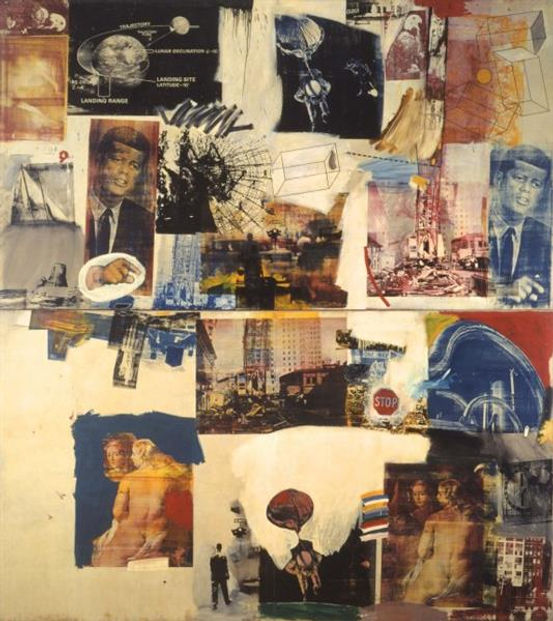
Skyway
Robert Rauschenberg
1964

Retroactive I
Robert Rauschenberg
1964

Buffalo II
Robert Rauschenberg
1964
Paul Rebeyrolle
1926 – 2005

Paul Rebeyrolle dans son atelier
Paul Rebeyrolle
(3 November 1926 in Eymoutiers – 7 February 2005 in Côte-d'Or) was a French painter.
As a child he had tuberculosis of the bone, which caused for long periods of immobility. Later he studied in Limoges and joined the French Communist Party. He ultimately broke with the party because of events related to the Hungarian Revolution of 1956.
His art is often concerned with landscapes, but is marked by violence and rage. He received praise from François Pinault, Jean-Paul Sartre, Michel Foucault and others. Some of his famous works are called "Frogs" 1966, "Still Life" 1966, and "Trout" 1956.

Paul Rebeyrolle dans son atelier

Paul Rebeyrolle

Paul Rebeyrolle

Paul Rebeyrolle

Paul Rebeyrolle

Paul Rebeyrolle

Paul Rebeyrolle

Paul Rebeyrolle

Paul Rebeyrolle

Paul Rebeyrolle

Paul Rebeyrolle

Paul Rebeyrolle

Paul Rebeyrolle

Paul Rebeyrolle

Paul Rebeyrolle

Paul Rebeyrolle

Paul Rebeyrolle

Paul Rebeyrolle